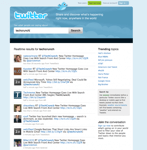It occurred to me this morning that I’ve been using social media for nearly over 14 years, and while I’ve been running a content marketing company in Canada and Australia for 4 of those years I’ve only just started using three of the world’s biggest social media platforms in the past 6 months. Here’s why...
When I first started using social media - it wasn’t called that.
I think it was only after the success of MySpace that Facebook appeared, then Twitter, Linked In – and then the types of social media tools just exploded and a new term was needed.
Remember MSN Messenger?
Before all of that, we only had MSN Messenger - very popular with the University and high school crowd – and their parents. MSN was initially as a social chat tool (and a wonderful distraction from doing what you were supposed to be doing, in my case, English essays at Queen’s University). But the desire for sharing more than just a conversation with a few friends was already there. And many people (myself included) made the tool even more “social" by changing our names frequently to inside jokes, moods, or song lyrics to communicate what we were doing in one conversation with the people on our list who weren't in the conversation. Back then, the only public element you could control was your name. You couldn't broadcast anything other than text, but you can see the desire for that social connection was there.
What about MySpace?
While I missed out on MSN’s successor, MySpace (I actually was doing my University homework that year during my Bachelor of Education, and working very hard as a new teacher) I was an early adopter of Facebook. As a high school English teacher in Australia, I always felt my claim to fame was that I was on Facebook before my students (because it was popular with my Canadian friends before my Australian ones).
Business Blogs and Newsletters are Social Media Marketing, Too
Business blogging, however, has always been a key part of Tangible Words' content marketing. Most people forget that blogging is actually a form of social media marketing; sharing ideas – i.e. content –to engage audiences across the internet = the definition of social media marketing. E-newsletters is another social media tool that Tangible Words has always used as a cornerstone of our social content marketing. Many of you have heard me refer in Tangible Words’
Content Marketing Programs to the first company
Vicky and I started, Leading Out, whose net value was increased by the effective use of our blog for SEO and user trust.
Sharing ideas – i.e. content – to engage audiences across the internet
= the definition of social media marketing."
Frequently publishing current effective content through Tangible Words' blog and e-newsletter has been Tangible Words’ biggest marketing focus for the first three years. These measures significantly impact and improve our SEO and increase user trust, and it’s only in the last six months that we’ve
started tackling new platforms. (And we’re a content marketing company!)
But we want our content marketing to be effective, we want to do it well, and we want to make sure we have the resources to
continue to do it well. Most importantly, we want our content on all our social media platforms to prove who we are: a team you can trust to manage your content marketing and
increase sales.
Before You Get on Social Media, You Have to Fix Your Website Content
So it’s with a bit of a head shake that I listen to people say “you have to get on social media immediately.” You actually don’t have to get on social media - you have to fix your website content first. Second, you have to have a content strategy for which social media tools you’ll use, what kind of content you’ll share, what you expect to get out of the tools, and a content policy for who, when, how often you’ll share your content. It’s actually step 3 that gets you onto social media. Skipping the first two steps means when you get to Step 3 you won’t have a good time.
It doesn’t matter what anyone else says - talk to entrepreneurs who have built and sold companies before, they know best. You won’t have business success with social media unless you do steps 1 and 2 first. In particular, pivotal to your success in content marketing online is the content strategy for how you will use that social media tool (i.e. what kind of content will be relevant to share, what audiences are you hoping to attract, and how will you define success?) and your content policy (how frequently will you post, who will be responsible, what kind of account will you set up, etc.).
The Case for Starting & Stopping Social Media Marketing
The greatest problem with social media marketing is that there are hundreds of tools you can use, and most people start with a handful of them all at once without really tracking their Return on Energy. That works ok...until they get to a point where they burn out and aren’t seeing the results they wanted, so they stop. I’ve always felt that stopping your social media once you’ve started is worse than not starting in the first place. It’s kind of like going to a website that proudly puts a “BLOG” link in the website’s navigational structure, but when you visit the company blog, you see the last post was more than six months ago.
One of the reasons we have always been attracted to the internet is the ability to find nearly “real time” information.
If your blog is older than six months, you can't claim to be up to date with current events and so your credibility becomes decreased in the eyes of your audience. Furthermore, it also speaks to either a disorganization or lack of resources and perhaps, professionalism...not the kind of business practices you want to share with your audience. It’s just one more case where actions really speak louder than any words you can say to try to disprove your actions.
Overcoming Your Social Media Fears
When we started doing our Business Blogging Content Marketing Program, one of the biggest fears espoused during the workshop had to do with publishing content - who would see it, who could comment, who would control comments. That fear of publishing our own voice has really decreased over the years, thanks to the popularity of Facebook especially. So we’re used to seeing friends post personal content all the time, and nearly everyone dabbles in sharing themselves online now - if only through minimalist “likes” and “shares”.
But when it comes to your business on Facebook, there are a couple of fears still to overcome:
- Audience: the people who “Like" your pictures of your family, are they the same ones who want to hear about your business?
- Content: what kinds of information would be relevant to share about your company that would reinforce the messages of your brand?
- Pushy Sales: we’re all weary of self-centred sales messages. You don’t want to turn off your loyal subjects and “friends” by annoying them with what seems like spammy content.
The solution to the first fear is your Social Media Content Policy. The Content Policy should include points like “Social Media Account Information.” You’ll likely post as a Company page and not as “yourself” on Facebook. This used to be unclear, and the iPhone Mobile app still doesn’t make it very easy, but if you go to your Company Facebook Page on your computer, you have the choice at the top to always select whether you post as “yourself” or as your “company” so you can move between the two accounts with ease.
Brainstorming Your Content Strategy
I’ve found that a lot of my friends and family are interested in the same stuff my company is interested in, they just wouldn’t recognize it unless I package it in an interesting way. It’s important that you do interest your family and friends on Facebook first because that’s one of the key ways to really grow your online presence. Start with the people who already know and like you, and use them as warm door knocks. But the essential point is that you have to really make the link to your content and their interests obvious. Here’s where your social media content strategy takes care of fear #2: sharing content that helps (not hurts) your brand.
The content strategy takes a lot of creative thought, and it’s best to do that thinking before you start using the tools themselves and get in the trap of overcommitting on social media. I’ve found that Jonah Berger’s book “
Contagious” was really helpful for giving an awesome T-Chart to use as a template for brainstorming “contagious” content. His 6 STEPS of Contagious content give you a place to start for what kinds of things you could talk about that would be interesting to other people.
I’ve also found a personal brainstorm to be helpful. For most small businesses, your company brand starts with who you are. So with Tangible Words, we started with "what people like about Alysha" in her social circles and at workshops, and we made another list of content ideas based on traits that showed Alysha’s personality, and we’re using that to build the Tangible Words Facebook brand and LinkedIn as well. You also listen to what your clients are asking you about, and then brainstorm idea on what interests your clients. Because at the end of the day, they are who you want!
Strategies that seem a natural fit with your Social Media Marketing.
The final fear can also be managed in these steps as you discover that who your company is, may be hard sales at the end of the day, but what makes people want to work with you is the relationship you extend. So sharing content based on your personality allows people to come to understand who you are and what they can expect from you—fostering trust through social media.
Putting it All Together For Social Media Marketing Excellence
Once that Content Strategy is established, and you’ve brainstormed content across the types of tools you’d like to start using, then you can return to your Content Policy regarding the frequency of your posts. The final step is to create a content marketing Editorial Calendar where you layout your content across your E-newsletter, Facebook, LI, Blog, etc. so it’s never a surprise what you’re writing about, and you don’t run out of content to share.
If you want to learn more about content marketing for your social media marketing, get yourself on the Tangy Words e-newsletter
digest.
-1.png)







